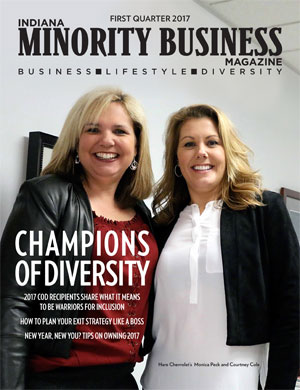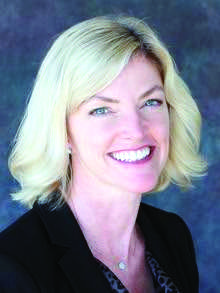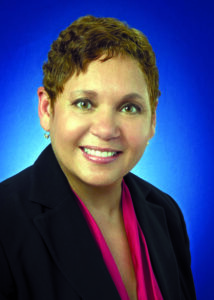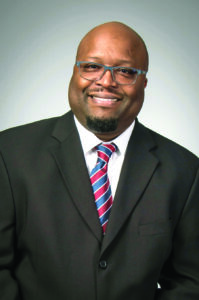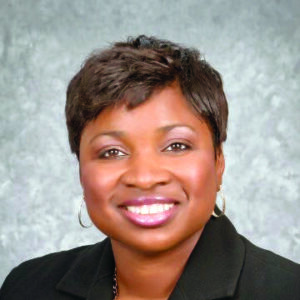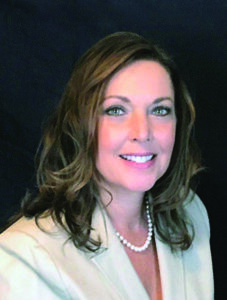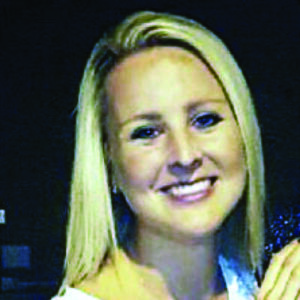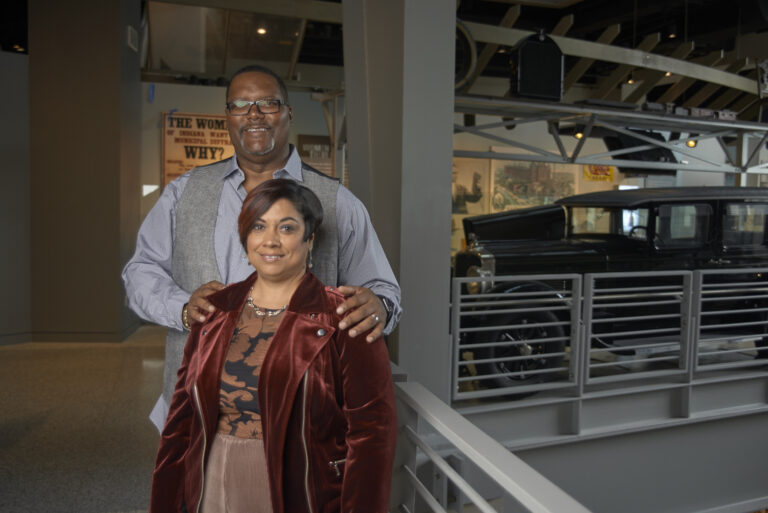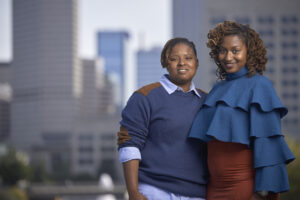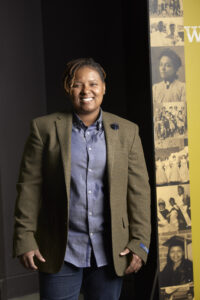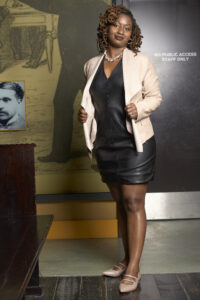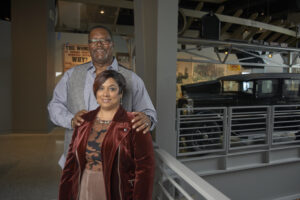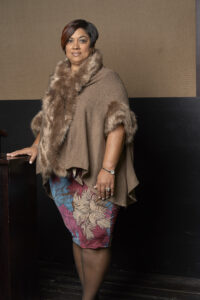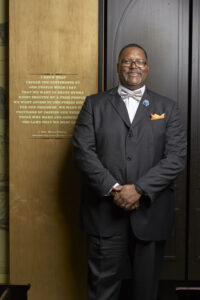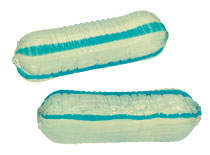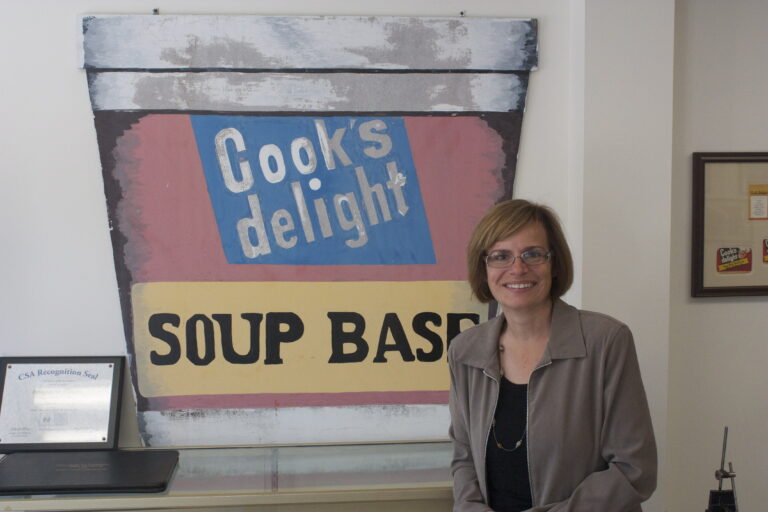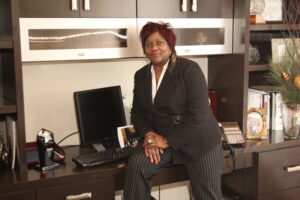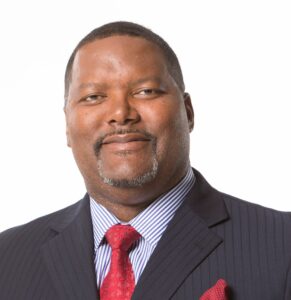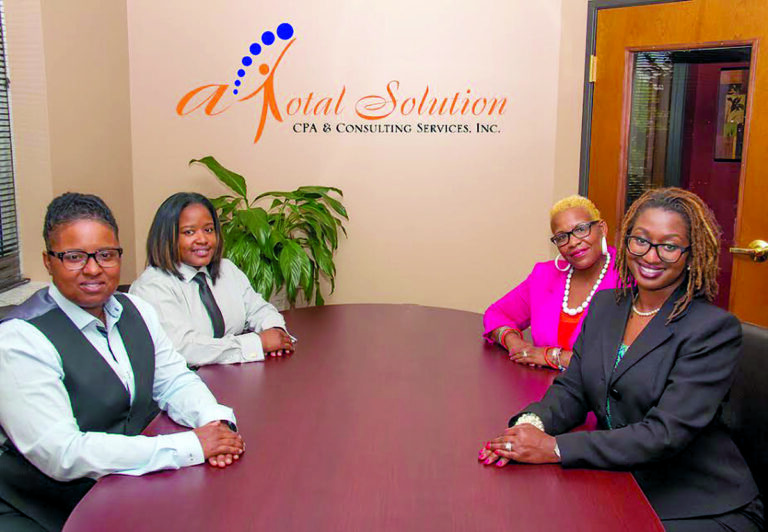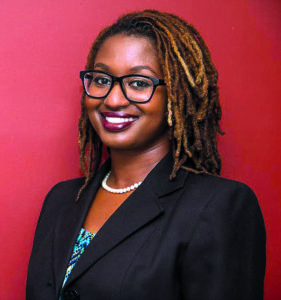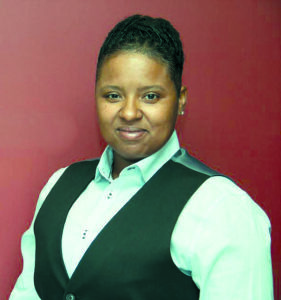Everyone benefits from a more diverse and inclusive community — whether at home, work, school, a place of worship, etc. Several community leaders have gone above and beyond when it comes to making Indiana more equitable for all.
On Jan. 13, 2017, IMBM recognized 13 honorees as part of the 2017 Champions of Diversity celebration. This distinguished group included businesses, organizations and individuals that have shown incredible efforts in the areas of diversity and inclusion.
A champion to us, particularly a Champion of Diversity, exhibits one or more of the following qualities: has transcended racial and/or gender barriers, has excelled in the area of diversity relative to hiring practices, exemplifies the epitome of diversity through outreach efforts and programs, advocates for or serves an under-represented or disadvantaged demographic, has made solid efforts and implemented processes to increase diversity.
Read on for inspiring stories of how this year’s award recipients are exhibiting these ideals in their everyday personal and professional lives.
Monica Peck and Courtney Cole
Monica Peck and Courtney Cole, co-owners of Hare Chevrolet in Noblesville, are champions of diversity and inclusion by the virtue of their gender; they are female business owners in a traditionally male-dominated field. But it extends far beyond that. They have made it a point to give back to the community over the years in hopes of continuing the legacy of their parents. (Cole and Peck bought majority ownership from their parents Dave and Jackie Cox in 2008.)
Peck says their parents truly led by example, supporting organizations like the Boys and Girls Clubs of Noblesville, which remains the dealership’s “charity of choice.” Peck said they tend to gravitate toward “youth oriented” organizations, but are open to supporting other worthy causes. For example, domestic violence awareness and prevention is also a pet cause, as it was a passion of their mother. Another cause that hits really close to home is lung cancer support and education. Cole was diagnosed in February 2014 with stage four lung cancer. She said it has been a “crazy journey,” but she is happy to help the local lung cancer association, however and whenever she can.
“We feel we need to give back, as much has been given (to us),” Cole said.
Philanthropy is just one of the many ways they reach the community. However, the organization’s internal makeup is impressive in and of itself.
“We have a diverse workforce, despite the (largely white) demographics of the area,” Peck said. “We have been able to bring in people from all walks of life.”
Women are just one of the groups represented at the dealership, which employs about 230 people. Cole said there is a growing number of female employees on the business development team. While there is no magic bullet for attracting more diverse candidates to the company, it has become a case of birds of a feather flocking together; it’s more organic than intentional.
“Once you get started, diversity tends to continue and becomes a natural part of the culture,” Cole said.
For example, it’s common for female employees to start in the business development department and move on to sales once they’ve seen their peers succeed. In Peck’s words, “We just develop a great training ground,” and the rest follows. Once employees get comfortable with interacting with customers, said Cole, they realize they can take it to the next level by going into sales.
The sisters say greater diversity is also good for their bottom line. A diverse customer base calls for cultural awareness and understanding.
“You have to reflect your clientele,” said Peck. “Most people are most comfortable doing business with people who understand them.”
Cole and Peck will accept the William G. Mays Excellence in Entrepreneurship award, which recognizes individuals or organizations that have garnered business success while also furthering the causes of diversity and inclusion.
Gregory S. Fehribach
Gregory S. Fehribach has dedicated his career to ensuring that people with disabilities have a voice and place at the table.
“What’s most important is that people with disabilities are being included in the conversation about what makes a diverse community,” he said.
An attorney with a disability who uses an electric wheelchair as a mobility aid device, Fehribach founded The Fehribach Group in 1995, where he provides innovative access solutions to clients who are continually creating an accessible environment that is welcoming to all guests.
Fehribach’s law practice affiliates with Doninger, Tuohy & Bailey LLP in Indianapolis. He is a Distinguished Fellow at Ball State University (Muncie, Indiana), where he coordinates the Disability Project. This initiative identifies barriers that people with disabilities face. Their work has helped Ball State be recognized as an inclusive, accessible and supportive community for students, faculty and people with disabilities nationwide. He also works with students with disabilities to secure and maintain sustainable employment as part of a partnership with Ball State’s Office of Disability Services.
It is Fehribach’s hope that such efforts will inspire employers nationwide to consider people with disabilities for employment. He advocates for “opportunities where we can integrate better into the fabric of society, as opposed to being on the outside looking in.”
To have that option, he said, provides a sense of freedom, which is a key theme of the Martin Luther King Jr. Freedom Award. This award is reserved for those individuals or organizations that have been instrumental in helping others achieve a certain level of freedom, despite adversity in their personal lives.
Fehribach defines freedom in this context as “the ability to earn a living and not be under the thumb of another,” adding that he feels grateful to have been afforded the opportunity to make a decent income.
But he said his peers with disabilities don’t always have that luxury. It starts with a cultural shift in the workforce.
“Employers must be comfortable having conversations with people with disabilities,” he said, “in order to break down, reduce or eradicate barriers.”
Though, he is quick to point out this isn’t always easy. In his words, “History will tell you that having these conversations has been uncomfortable.” Still, as he noted, achievements like shattering the glass ceiling and advancing civil rights were made possible because people cared enough to take action.
Dr. George Rawls
Sometimes making progress in these areas means overcoming adversity in your own life. Dr. George Rawls, a retired surgeon, is a prime example. Rawls entered medical school in the late 1950s, during a time of high racial tension in America.
Rawls completed his undergraduate studies at Florida A&M University. At the time, it was expected that candidates to medical programs submit a photo with the application. As Rawls explained, he was denied acceptance to several schools based on “his Negro status.” He was ultimately accepted into Howard University’s medical school, but not without any struggle. The then-university president didn’t think Rawls should pursue medicine, given the great deal of civil unrest and injustice that was brewing in American society. Social work was suggested as a noble path. Rawls compromised and committed to doing medical work in the community — a legacy that continues today.
“It means that I have done what I promised I’d do,” he said about being honored with the Rosa Parks Trailblazer Award.
In other words, it’s the ultimate affirmation. The Rosa Parks Trailblazer distinction recognizes someone who has been innovative by either creating a new initiative, service or program for the purpose of furthering inclusion efforts. Rawls was president of the Indianapolis chapter of the Aesculapian Medical Society from 1960-1963.
The Aesculapian Medical Society has long supported the continued advancements of African-American doctors into medical education and hospital administrative positions. Throughout its history, the organization has focused primarily on health issues related to the African-American community and medically underserved populations; its principles, goals, initiatives and philosophy encompass all sectors of the population.
His professional and personal legacy is one of breaking through barriers. In addition to his service to the Aesculapian Medical Society, Rawls was the first Black physician to serve as president of the Indianapolis Medical Society. The late Dr. Frank Johnson is the only other Black physician to serve as president since then. Rawls went on to be the only Black physician to serve as president of the Indiana State Medical Association (ISMA) from 1989-1990.
Despite these distinctions, Rawls remains humble.
“I enjoyed taking care of patients. It’s a joy to see patients again after operating on them (sometimes several years prior),” he said.
This bedside manner has served him well in his career, beyond the operating room. He has assumed the role of an educator, authoring several books including “Managing Cancer: The African American’s Guide to Prevention, Diagnosis and Treatment,” “The Surgeon’s Turn”, and “Papa, I want to be a Surgeon.”
OTHER WINNERS
There are 13 total recipients of the Champions of Diversity award. Find out what this honor means to the honorees who responded to our question: “What does being a Champion of Diversity mean to you?”
Jonathan Balash/ President & Director/Spencer Pride
“A Champion of Diversity promotes acceptance of one another’s differences in a way that encourages others to do the same. They help to educate about underrepresented groups to ensure that they cultivate a community that is compassionate to and welcoming of ALL people. At Spencer Pride, this is a core part of what we do. Each of our volunteers is a Champion of Diversity. They engage with people every day in an effort to educate about diversity and to promote equality. This is hard and often uncomfortable work, but it is necessary and fulfilling work.”
Andrea DeMink/Executive Director/The PourHouse
“Being a Champion of Diversity means celebrating each person for who they are, no matter where they are in life or how society tries to define them. Each person that The PourHouse encounters is regarded as a peer and not a project. Homelessness is an experience they are having, not an identity that they carry.”
Carolyn E. Mosby/President & CEO/ Mid-States Minority Supplier Development Council
“A Champion of Diversity is a leader and advocate for what is fair and equitable — even in the face of adversity. They also are tuned in to the challenges and opportunities for advancing diversity through fostering ideas and perspectives from a diverse group of people, reflective of our society.”
Terri L. Roberts-Leonard/Director of Diversity & Inclusion/Franklin College
“For me, being a Champion of Diversity means working toward positive change, growth and development when it comes to issues of multiculturalism, diversity and social justice. We must ‘take ownership’ of diversity and inclusion efforts. Too often, lip service is given to diversity, and institutions fail to provide the support needed (be it manpower or financial) to make progress doing this important work. They support the concept of diversity and inclusion, but they don’t really know how to activate it. They need to be able to talk knowledgeably about the theories behind diversity and inclusion work and have people in place with the skills to take effective action. At Franklin College, we have made great strides in the past four years to increase diversity education, not only on campus, but also in the surrounding community. I am humbled to have been selected among such a wonderful and talented group of individuals and organizations. I will continue to work hard toward the ultimate goal of equality for all.”
Barbara S. Ellsworth/Executive Director/Dress for Success Indianapolis
“Bringing together people from different walks of life, who have different experiences, ideas and backgrounds, is the core of what we do at Dress for Success Indianapolis. Our strength lies in that diversity; it allows us to be better advocates for our women and better members of our community. We truly believe that we can achieve more together than we ever could alone.”
Marco Dominguez/Director of Community Relations/ Financial Center Credit Union
“(Being a) Champion of Diversity means a lot to me. Every day I have the unique opportunity to be in our community talking with all walks of life. No matter what their color, race or status is, I am thankful that I have the opportunity to meet with them and address their needs. My personal motto is ‘to serve, listen and act,’ and I have the pleasure and position to do what I love and share with everyone that I encounter. So a Champion of Diversity is ALL that, including everyone, serving all different types of issues and relentless dedication.”
Ellen D. Wu/Associate Professor of History/Indiana University
“It is inspiring to know that there are so many individuals and institutions in Indiana who are working to ‘champion diversity’ at so many different levels and in so many different ways. As an educator, I try to call attention to the long and deep history of inequities and indignities in the United States. Armed with such knowledge, I am hopeful that all Americans can work together to make justice a reality for the most marginal and vulnerable among us.”
Nicole Bell/Diversity Manager/Honda Manufacturing of Indiana
“Being a Champion of Diversity means being a voice and working to create a truly inclusive environment where all people bring their full selves to work. It’s about creating an environment where diversity of thought, background and experience are welcome and the way of life. It also means ensuring that inclusion and diversity are represented in all processes in our business — from our HR to suppliers, communications and external community impact.”
Max Siegel, of USA Track and Field, and Purdue University are also 2017 Champions of Diversity award recipients.
Diverse Firsts
Here’s a look at a few historic “firsts” accomplished by ethnic minorities and women in Indiana:
- An inventor of natural hair care products, Madam C.J. Walker was the first African-American female millionaire in the country. She was also known for her philanthropic endeavors including donating the largest amount of money by an African-American toward the construction of an Indianapolis YMCA in 1913.
- Sarah Bolton, of Indianapolis, was considered the first poet laureate in Indiana for her work in the 1840s and ’50s.
- Dr. Mary Thomas was admitted as the first woman member of the American Medical Association in 1876.
- David Baker was a regular on the thriving Indianapolis jazz scene of the era. A 1973 Pulitzer Prize nominee and Indiana University professor, Baker was nominated for a Grammy Award in 1979 and honored three times by DownBeat magazine — as a trombonist, for lifetime achievement and as the third inductee into its Jazz Education Hall of Fame.
- A graduate of what is now the University of Indianapolis, William Raspberry was a Pulitzer Prize-winning columnist for The Washington Post for nearly 40 years. He was one of the first Black journalists to gain a wide following in the mainstream press.



